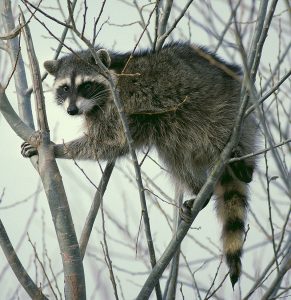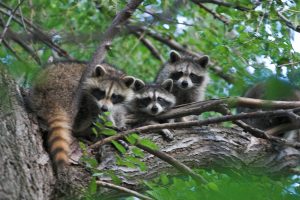Urban areas, suburbs, and farms likewise make good homes for raccoons, who have adapted to city life by learning to scavenge from 
garbage cans, gardens, and crop fields. Wild raccoons typically nest in tree cavities, rock crevices, underground burrows, and the abandoned dens of other animals, such as muskrat lodges. In suburban areas, the animals have been known to seek the shelter of unoccupied buildings.
Raccoons like to live in woodland areas near water sources such as rivers, marshes, and streams. Much of their food supplies comes from aquatic invertebrates such as clams, crayfish, turtles, and snails.  The masked creatures also eat a large variety of plant-based foods, such as acorns, fruits, vegetables, nuts, and corn.To keep the small, furry animals away from homes and property, be sure to eliminate food sources that draw them near. Placing guards on top of chimney openings and sealing up all gaps along the exteriors of attic walls also serves to keep raccoons from gaining entry to homes.
The masked creatures also eat a large variety of plant-based foods, such as acorns, fruits, vegetables, nuts, and corn.To keep the small, furry animals away from homes and property, be sure to eliminate food sources that draw them near. Placing guards on top of chimney openings and sealing up all gaps along the exteriors of attic walls also serves to keep raccoons from gaining entry to homes.
In residential yards, stalks of vegetable plants may be broken and vegetables or fruits stripped by raccoons overnight. Chicken coops often face danger in the wake of raccoon presence, as hungry raccoons capable of opening fence latches can find their way inside and destroy eggs, birds, and nests.
Raccoons are protected fur-bearing animals.
 They have legal protections as game animals in most states. Live trapping and relocation may not be an option, since in some states it is illegal to transfer and release captive animals in areas other than the original capture site. Certified wildlife specialists and licensed trappers are required in order to dispose of, and remove problem raccoons, outside of specified seasons.
They have legal protections as game animals in most states. Live trapping and relocation may not be an option, since in some states it is illegal to transfer and release captive animals in areas other than the original capture site. Certified wildlife specialists and licensed trappers are required in order to dispose of, and remove problem raccoons, outside of specified seasons.
Wild raccoons typically nest in tree cavities, rock crevices, underground burrows, and the abandoned dens of other animals, such as muskrat lodges. Yards containing easily accessible sources of food, such as outdoor pet food containers, vegetable gardens, unsecured trash bags, and compost heaps, often attract raccoons into residential areas. If a raccoon is fed or becomes comfortable living around humans, it may attempt bold moves such as entering homes through pet doors to raid kitchens for food. Chicken coops often face danger with raccoon presence, as hungry raccoons capable of opening fence latches, can find their way inside, and destroy nests, birds, and eggs.

Raccoons are mammals that are common and nocturnal throughout the United States and North America, especially the wooded regions of the United States. These smart creatures have nimble hands and are intelligent problem solvers capable of opening latches, turning doorknobs, climbing, swimming, and running at speeds of over 10 miles per hour. Besides the native northern raccoon, there are six other existing species, most of which live on tropical islands.
The small, stocky animals are covered in gray fur with distinctive black markings in the shape of a bandit’s mask around their eyes and rings along their fluffy tails. Raccoons have black eyes, short ears, and small black noses at the end of their short, narrow snouts. Because their back legs are longer than their front legs, the animals appear hunched as they walk.
Yards containing easily accessible sources of food, such as outdoor pet food containers, vegetable gardens, unsecured trash bags, and compost heaps, often attract raccoons into residential areas. Female raccoons, known as sows, may build nests in empty buildings, attics, sheds, chimneys, and garages to raise young kits during the spring. It may attempt bold moves such as entering homes through pet doors to raid kitchens for food if a raccoon is fed or becomes comfortable living around humans.

